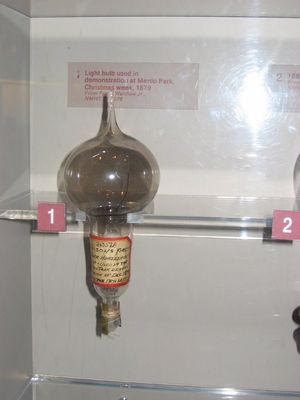Edison's Incandescent Lamp: Difference between revisions
m (<replacetext_editsummary>) |
No edit summary |
||
| Line 1: | Line 1: | ||
<p>'''''This article is a stub. You can help the ETHW by expanding it.''''' </p> | <p>'''''This article is a stub. You can help the ETHW by expanding it.''''' </p> | ||
Inventor Thomas Edison of Menlo Park, New Jersey first patented his carbon-filament lamp on November 1st, 1879. His laboratory first produced promising results for this electrical lamp on October 21st, 1879; a glowing carbonized thread which lasted for more than fourteen (14) hours. Publically demonstrating this invention at Menlo Park on December 31st, 1879, Edison is known to many as the “inventor of the electric light bulb”. However, he is not the inventor of the light bulb, but rather the inventor of the first effective and commercially viable one. | |||
==History and Early Research== | |||
Early light bulb experimentation dates back as far as 1802, with several other inventors working on the task prior to, during, and after Edison’s own work. | |||
===The Arc Lamp=== | |||
British inventors first demonstrated the possibility of electric light with the arc lamp; a lamp which produced light via an electric arc. Created by Humphrey Davy in 1802, the first instance incandescent light was demonstrated by passing a current through a thin strip of platinum; a metal chosen because of its high melting point. Although it was not very bright or effective as a long-term lighting solution, it created the precedent for the years of scientist’s efforts which followed it. | |||
<p>[[Image:Edison bulb.jpg|thumb|center|Edison's First Lightbulb as used in Menlo Park demonstration. Source www.classstudio.com/scaltagi/img/internship/sightseeing_day2/edison_bulb.jpg]]</p> | <p>[[Image:Edison bulb.jpg|thumb|center|Edison's First Lightbulb as used in Menlo Park demonstration. Source www.classstudio.com/scaltagi/img/internship/sightseeing_day2/edison_bulb.jpg]]</p> | ||
[[Category:Lasers,_lighting_&_electrooptics]] | [[Category:Lasers,_lighting_&_electrooptics]] | ||
[[Category:Electric_lighting]] | [[Category:Electric_lighting]] | ||
Revision as of 19:15, 31 March 2015
This article is a stub. You can help the ETHW by expanding it.
Inventor Thomas Edison of Menlo Park, New Jersey first patented his carbon-filament lamp on November 1st, 1879. His laboratory first produced promising results for this electrical lamp on October 21st, 1879; a glowing carbonized thread which lasted for more than fourteen (14) hours. Publically demonstrating this invention at Menlo Park on December 31st, 1879, Edison is known to many as the “inventor of the electric light bulb”. However, he is not the inventor of the light bulb, but rather the inventor of the first effective and commercially viable one.
History and Early Research
Early light bulb experimentation dates back as far as 1802, with several other inventors working on the task prior to, during, and after Edison’s own work.
The Arc Lamp
British inventors first demonstrated the possibility of electric light with the arc lamp; a lamp which produced light via an electric arc. Created by Humphrey Davy in 1802, the first instance incandescent light was demonstrated by passing a current through a thin strip of platinum; a metal chosen because of its high melting point. Although it was not very bright or effective as a long-term lighting solution, it created the precedent for the years of scientist’s efforts which followed it.
